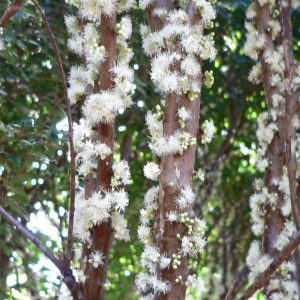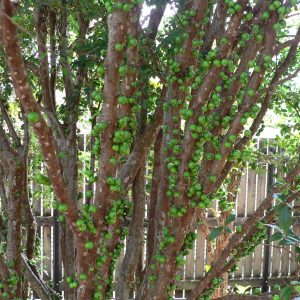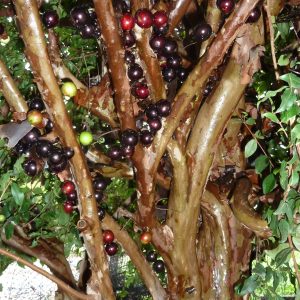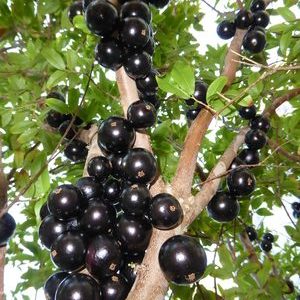Plinia (Myrciaria) cauliflora
Jaboticaba, Brazilian grape
Origin
Brazil and areas of Bolivia, Paraguay and north east Argentina.
Climate
Its natural range is in latitudes from about 32° to 16° south, elevations up to 1000m, average precipitation of >1200mm pa, and mean annual temperatures of 22-25°C. It can survive slight frost but growth will slow with cooler temperatures.
Heavy rain may cause it to shed leaves, but it will survive waterlogging.
Plant Description
The tree is a handsome, slow-growing evergreen tree that can reach 10 to 12m in good conditions. The bark peels off in small patches. The leaves are small, reddish when young and turning glossy green with maturity. There is also a large leafed variety with leaves up to 6cm. Branches tend to develop close to the ground and plants can become bushy.
Relatives
Myrtaceae Family, which also includes many Eugenias and Syzygiums, guavas, feijoa and Ceylon hill gooseberry.
Soils
A deep, rich, well-drained soil with a pH range of 5.5 to 6.5 is recommended for best growth. However it is widely adaptable and will grow satisfactorily even on alkaline beach-sand type soils, as long as it is tended and irrigated.
Propagation
Seeds come reasonably true but are recalcitrant. Some are polyembryonic. Grafting and inarching are used to propagate varieties with desired characteristics.
Cultivars
Younghans, FJI, and Whitman were early importations
Flowering and Pollination
Cauliflorous inflorescences occur in racemose clusters of 2-4 on short pedicels. Individual flowers have 4 petals and about 60 stamens. They are white and highly perfumed. If it is given sufficient water, it will flower frequently. Pollination is by bees and other insects.
Cultivation
Needs ample water at all times, irrigation in the top 25-50mm as the root system is shallow. Keep well mulched.
Wind Tolerance
Good, but they cannot withstand much salt wind and so should be protected if close to the ocean.
Pruning
Thin the bushy interior, and keep the plant to a reasonable size. If fruit set is very heavy, fruit thinning will increase remaining fruit size.
The Fruit
The fruit is a thick-skinned berry and typically measure up to 4cm in diameter, resembling a grape. It has a thick, purple, astringent skin that encases a sweet, white or pink gelatinous flesh. There are 1-4 large seeds, which vary in shape depending on the species. The flesh is tightly attached to the seed. Flavour is “excellent” with a Brix of 17.5, plus it has a reasonable level of vitamin C.
Fruit Production and Harvesting
A slow-growing plant, seedlings may begin flowering and fruiting at 5 or 6 years or more. Vegetatively propagated trees might begin at about 4 years. The fruits take about 6 weeks from bud to green fruit, turning maroon, then black and then shiny black.
Fruit Uses
Jaboticabas are eaten as a table fruit, often with skin on, but large quantities of skin should not be eaten because of tannins. They are used in jellies, juices and wine-making.
Pests and Diseases
Fruit flies may not be a problem because of the thick skin, but birds love the ripe fruits.
Comments
As an attractive, compact plant that provides a steady supply of tasty family fruit on even the smallest suburban



